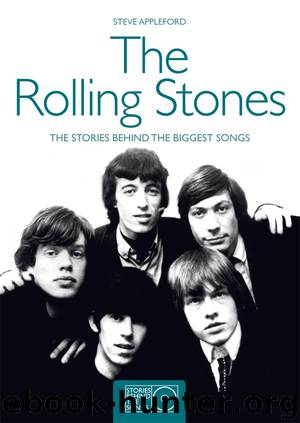Rolling Stones by Steve Appleford

Author:Steve Appleford
Language: eng
Format: epub
Publisher: Carlton Books Ltd
Published: 2012-09-19T04:00:00+00:00
STICKY FINGERS
Behold Rolling Stones Records. Behold the mighty tongue, those bright red lips, and a sound both confident and fine, bringing rock and roll into a strange new era. The 1970s were finally upon us, and the snappy lips-and-tongue cartoon logo signalled that Jagger and his cohorts were now somehow “in charge”. A ghastly development, no doubt, for the cops and tastemakers out to bring down these loud-mouthed London minstrels. Now they weren’t even within reach – by 1971 the Stones had declared themselves tax exiles from Mother England, and were living in heathen splendor in the south of France, or wherever, and not much concerned about any bad news they might have left behind.
No longer would there be those irritating battles over taste and decorum. The first sign of a new enlightened age came in the form of Sticky Fingers, released by Rolling Stones Records, a “boutique” label distributed via a licensing agreement through Atlantic Records. Running the company was Marshall Chess, the 29-year-old son of Leonard Chess, the sainted founder of Chess Records. And for the label’s first release, pop artist Andy Warhol created an audacious cover that depicted a suggestive pair of jeans, complete with bulging crotch and a working zip. Sticky fingers, indeed.
The Rolling Stones had been reborn yet again in the months leading up to the release of Sticky Fingers. Young Mick Taylor’s impressive guitar was now fully incorporated into the band, and to great musical effect – evidence enough of this could already be heard on the single ‘Honky Tonk Women’. And Mick Jagger was even threatening to become a movie star, with three films – One Plus One, Ned Kelly and Performance – all released in 1970. And the Stones were finally free agents, no longer indentured labourers for Decca Records in the UK, London Records in the US, or former hero and manager Allen Klein.
Equally important was the band’s return as a touring unit. The sudden exit of the sadly dazed and confused Brian Jones now made it possible for the band to perform across Europe and the United States during 1969 and 1970. Powered by new sound technology, the Rolling Stones were now capable of filling sports venues with ear-rattling rock and roll. The screaming teenage girls were long gone, instead they had been replaced by enormous crowds ready to tap into the Stones’ dark, bluesy groove. Outside the halls were the usual clashes between fans and police.
Then, of course, there was Woodstock, that massive rock festival happening in upstate New York that seemed to represent the hopeful side of sixties pop culture. JImi Hendrix, the Who, Janis Joplin, Creedence Clearwater Revival, Crosby Stills Nash and Young, Santana, Melanie (!) and countless others had mixed with the rain, mud and acid for three days of mostly good vibes. All that was missing was a representative of one of the decade’s great pop triumvirate: the Beatles, Dylan or the Stones.
At the end of 1969, the Rolling Stones sought to recreate Woodstock in their own image with a free concert in San Francisco’s Golden Gate Park.
Download
This site does not store any files on its server. We only index and link to content provided by other sites. Please contact the content providers to delete copyright contents if any and email us, we'll remove relevant links or contents immediately.
The Goal (Off-Campus #4) by Elle Kennedy(13207)
Kathy Andrews Collection by Kathy Andrews(11331)
Diary of a Player by Brad Paisley(7270)
What Does This Button Do? by Bruce Dickinson(5936)
Assassin’s Fate by Robin Hobb(5858)
Big Little Lies by Liane Moriarty(5519)
Altered Sensations by David Pantalony(4872)
Pale Blue Dot by Carl Sagan(4626)
Sticky Fingers by Joe Hagan(3916)
The Death of the Heart by Elizabeth Bowen(3342)
The Heroin Diaries by Nikki Sixx(3325)
Beneath These Shadows by Meghan March(3153)
Confessions of a Video Vixen by Karrine Steffans(3104)
The Help by Kathryn Stockett(3021)
How Music Works by David Byrne(2968)
Jam by Jam (epub)(2880)
Harry Potter 4 - Harry Potter and The Goblet of Fire by J.K.Rowling(2813)
Strange Fascination: David Bowie: The Definitive Story by David Buckley(2702)
Petty: The Biography by Warren Zanes(2575)
